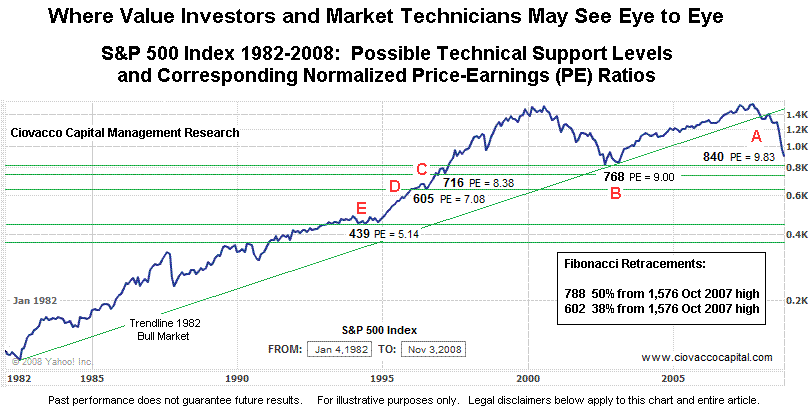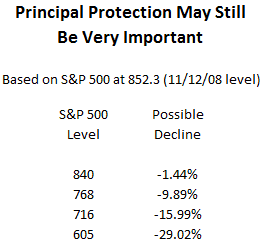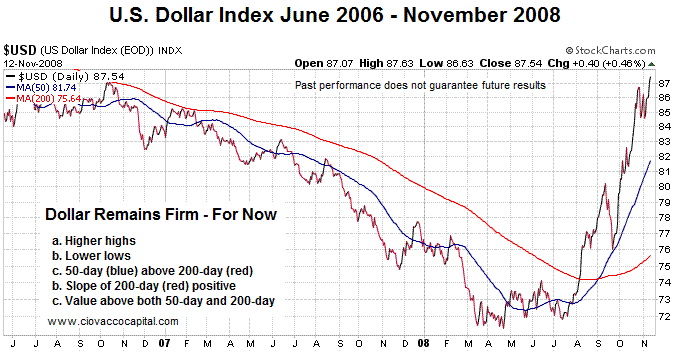Where Stock Market Valuations and Technical Support Intersect
Stock-Markets / Stock Market Valuations Nov 13, 2008 - 12:04 PM GMTBy: Chris_Ciovacco
 Where observation is concerned, chance favors only the prepared mind.” Louis Pasteur (1822-1895)
Where observation is concerned, chance favors only the prepared mind.” Louis Pasteur (1822-1895)
The basic fundamental value in buying a stock or a business is the cash flow it can produce over time. Investors discount expected cash flows to a single present value to come up with a valuation for a stock or business. You value a stock the same way you would value a dry cleaning business. A prospective buyer of a dry cleaning establishment wants to know how much cash it can produce over time after all the bills are paid.
Discounting the anticipated future cash flows of a business to the present (time value of money) helps you determine what the dry cleaner is worth today (valuation). To make sure you do not overpay for the business, you should discount earnings from both periods of economic expansion and economic contraction. The dry cleaner's profit margin, like most businesses, will be higher in good times and lower during recessions. Using a single year's cash flow or revenue will not paint an accurate picture of the business' true value to an owner.
As an investor, if you feel Johnson & Johnson (JNJ) is going to be around for the foreseeable future, you should evaluate the stock as if you were going to buy the whole business by discounting anticipated cash flows. Stockholders basically own a partial claim to future cash flows. Using this rationale, value investors have the guts to step in and buy good businesses during a bear market (when they are cheap). As bad as things are now, we all know numerous companies will still be producing free cash flow (real profits) for many years to come. Not all public companies are going the way of Bear Stearns. I think it is reasonable to assume that businesses like Coca-Cola, McDonald's, Microsoft, Proctor & Gamble, and Wal-Mart will be viable in five years.
Since stocks were trading at inflated valuations for many years, investors still need to evaluate what a claim to the future cash flows is worth. A good stock has relatively stable long-term cash flows at a fair price. Price-earnings ratios (PEs) are used to track the valuations of stocks or stock indexes. A PE ratio tells us how much investors are willing to pay for $1 worth of earnings. When PEs are relatively high, investors are willing to pay more for the earnings/cash flows of businesses. Conversely, when PEs are low, investors are willing to pay much less for future cash flows/earnings.
Every Man Has His Price and Support Level
Odds of success for investors are highest when we have both favorable fundamentals and favorable technicals. From a technical perspective, support is an area or price level on a chart where buyers have previously stepped in to buy and halted a decline in price. Support shows where investors in the past have seen relative value in the price of a security (business) or index (a group of businesses).
Just as in the dry cleaning example above, investors should not evaluate a stock solely on peak (expansion) or trough (recession) earnings since the value of the business is determined by the anticipated long-term future cash flows, which will include good and bad times. To get a better feel for the long-term value of a business, we can use normalized earnings or normalized PE ratios. True value investors care about normalized PE ratios, not PEs based on current earnings or anticipated earnings for two or three quarters. If we discounted Home Depot's anticipated future cash flows for the next year, do you think the present value of four quarters worth of earnings would paint a true picture of the business' long-term value?
The normalized earnings for the S&P 500 (used to derive PEs) in the chart below were calculated by John Hussman and explained in Risk Management and Hooke's Law . The chart below shows the normalized PE ratio for the S&P 500 at various levels of technical support. The areas labeled A thru E show potential areas of technical support for the S&P 500 should the market continue to decline. The PE shown for each corresponding level on the S&P 500 (439-840) is based on Hussman's normalized S&P 500 earnings.

On a relative basis, the area with the strongest technical support and reasonable valuation is near 768 on the S&P 500 (labeled B in chart). The S&P 500 closed at 852 on Wednesday (11/12/08). Support at A (840) may hold, but recent technical activity has been questionable. While the market never delivers a perfect anticipated outcome, a good sign would be for stocks to open weak near a support level and maybe even make a new intraday low early in the session. In the afternoon, we would like to see buyers step in and have stocks close in positive territory and above the nearby support level. If the “reversal day” occurs on very heavy trading volume, it would add to its potential significance. Another “follow through” day should come soon after the reversal day. The gains on the follow through day should be significant and also occur on strong volume. Some variation of the scenario described above would give institutional investors additional confidence to buy stocks.
Due to weak and deteriorating fundamentals (serious systemic problems), stocks may plow through both 840 and 768 during future weakness – or they may not. What happens at these support levels will dictate our allocation decisions. We are going to have to stay alert and see how things unfold.
Point C (716) valuations would be even more attractive than point B (768), but the technical support is weaker. Point D (605) offers slightly better hope for support than point C (716). With a normalized PE of 7.08 at point D, the odds are very good attractive long-term valuations would bring buyers off the sidelines. If the S&P 500 does not hold at point D (605), it really might “be different this time.” The bear market has the potential to do significantly more damage to buy-and-hold investors if support near 768 does not hold. A break of 768 would most likely bring a significant amount of shorts back into the market.
It is interesting to note that another method used by market technicians also points to potential support at 788 and 602 on the S&P 500. Fibonacci calculations are used to determine typical retracements during market pullbacks. 788 represents a 50% retracement from the S&P 500's October 2007 high of 1,576. 602 would be a 38% retracement.
A Big Picture Look At Our Longer-Term Objectives
- Protect Principal: A large cash position is still warranted. Having some one, two, and three month CDs continually rolling over will force us to be patient with some capital while remaining flexible should the market find its footing. We are watching almost every investment option available to individual investors. With the exception of U.S. Treasury bonds, the U.S. Dollar, and Japanese Yen, everything is and has been losing money. The list of money losers includes oil and gas trusts, preferred stocks, dividend-paying stocks, gold, and TIPS. With the rush to “safety” and the unwinding of carry trades, gains in Treasuries, the Dollar, and Yen may be subject to rapid reversals even on a minor improvement in market conditions.

- Do Not Chase Yield on Anything (Yet): This includes locking yourself into long-term CDs or a fixed annuity with an attractive teaser rate. Inflation will be an issue in the future. It could be a very serious issue. Over the next three to five years, interest rates may move higher at a surprisingly rapid rate. A 5.0% CD may be very unattractive sooner than most think. In general, higher-yield comes with higher risk. Banks with weak balance sheets gather capital by offering above market CD rates. Insurance companies in need of funds may offer teaser fixed annuity rates above what their more stable and better managed competitors offer. Yes, CDs are FDIC insured. But, in this environment things can deteriorate and change rapidly. It is not worth the extra yield for the added risk and uncertainty that comes along with it. There will be a time to look for better yields. It is still too early in the cycle. Seeing higher highs and lower lows on some income-producing securities would be a nice start.
- Understand The Implications Of The Seemingly Endless Government Bailouts, Equity Stakes, and Loans: Inflation is primarily triggered by an excessive expansion in government liabilities relative to economic output. When the government sells bonds to finance the deficit, the proceeds flow back into the economy via government spending, increasing the money supply in the real economy. If I exchange "dead money" in a shoebox for a government bond, we end up with more "active money" in the economy and a piece of paper (a bond) in my shoebox. While I was sitting on "dead money" in my shoebox, you can rest assured our politicians will spend the proceeds from the sale of the bond (or they already have spent it). A rapid expansion in the "active" money supply adds to pricing pressures. This is not a big issue in the current state of economic disarray. However, when some stability returns to the financial system and global growth finds its footing, you can bet the ranch inflation will become a major concern for people around the globe. When the economic clouds begin to clear, the government cannot “undo” the rapid expansion in deficit spending. If you have not noticed, the government has “slightly” increased spending in recent months. The seeds of future inflation have been planted – a lot of seeds.
- Shift from Principal Protection Back to Purchasing Power Preservation: Cash, CDs, and fixed annuities do not help investors protect their purchasing power during periods of high inflation. Mentally, you should be preparing yourself to reenter asset markets that can help protect your purchasing power. When gold, oil, and the CRB index (commodities) begin to make higher highs and lower lows, it will be time to begin a migration from principal preservation to purchasing power protection. For older Americans, this transition may be the most important financial undertaking in their lives. Managing this transition will be difficult for the most seasoned investors, much less the part-time do-it-yourselfer.
- Don't Shift Back To Purchasing Power Protection Assets Too Soon: Those of us who are close to the markets are appropriately concerned about the rapid expansion in government liabilities. It is tempting to buy gold, oil, and short the U.S. dollar. Gold and oil continue to make lower highs and lower lows which is the definition of a downtrend. Trying to catch a falling knife may destroy hard-earned principal. Some frustration inevitably lies ahead in all asset classes as we can expect to get rallies and sharp retracements.
- Review Any Liability With A Variable Interest Rate: Mortgage rates went as high as 18.45% during a period of high inflation in the early 1980s. Enough said.
- Keep An Open Mind: The bursting of the credit bubble across all asset classes is a serious and unique problem that should be respected. However, the S&P 500 has lost 46% of its value since the October 2007 peak. These staggering declines (especially if you did not follow a disciplined strategy to cut losses) have already discounted some of the bad news that lies ahead. Market participants are well aware earnings and economic news will be quite bleak for an extended period and at least some of the future news is already built into stock prices. Only time will tell whether all the bad news has been discounted. We have very serious problems, but 46% is a very serious decline. We are currently in a battle of a primary downtrend in stocks which eventually will be counteracted by attractive valuations. Currently, the primary downtrend firmly retains the upper hand.
- Patiently Watch The Dollar: Being concerned about inflation and future dollar weakness go hand in hand. Long-term fundamental concerns about the dollar are warranted, but it is too early to bet against the greenback. Gold and oil look somewhat like a mirror image of the dollar's chart, which means the path of least resistance for both remains lower (for now – subject to change).

- Let the Market Come to You: Sports fans are familiar with the expression "let the game come to you." Just like a good athlete, we should not try to force our beliefs on the market. If we pay attention and remain patient, the market will help us make decisions when better risk-reward ratios exist. This is not the time to be throwing up indiscriminate "three-pointers".
By Chris Ciovacco
Ciovacco Capital Management
Copyright (C) 2008 Ciovacco Capital Management, LLC All Rights Reserved.
Chris Ciovacco is the Chief Investment Officer for Ciovacco Capital Management, LLC. More on the web at www.ciovaccocapital.com
Ciovacco Capital Management, LLC is an independent money management firm based in Atlanta, Georgia. As a registered investment advisor, CCM helps individual investors, large & small; achieve improved investment results via independent research and globally diversified investment portfolios. Since we are a fee-based firm, our only objective is to help you protect and grow your assets. Our long-term, theme-oriented, buy-and-hold approach allows for portfolio rebalancing from time to time to adjust to new opportunities or changing market conditions. When looking at money managers in Atlanta, take a hard look at CCM.
All material presented herein is believed to be reliable but we cannot attest to its accuracy. Investment recommendations may change and readers are urged to check with their investment counselors and tax advisors before making any investment decisions. Opinions expressed in these reports may change without prior notice. This memorandum is based on information available to the public. No representation is made that it is accurate or complete. This memorandum is not an offer to buy or sell or a solicitation of an offer to buy or sell the securities mentioned. The investments discussed or recommended in this report may be unsuitable for investors depending on their specific investment objectives and financial position. Past performance is not necessarily a guide to future performance. The price or value of the investments to which this report relates, either directly or indirectly, may fall or rise against the interest of investors. All prices and yields contained in this report are subject to change without notice. This information is based on hypothetical assumptions and is intended for illustrative purposes only. THERE ARE NO WARRANTIES, EXPRESSED OR IMPLIED, AS TO ACCURACY, COMPLETENESS, OR RESULTS OBTAINED FROM ANY INFORMATION CONTAINED IN THIS ARTICLE. PAST PERFORMANCE DOES NOT GUARANTEE FUTURE RESULTS.
Chris Ciovacco Archive |
© 2005-2022 http://www.MarketOracle.co.uk - The Market Oracle is a FREE Daily Financial Markets Analysis & Forecasting online publication.



